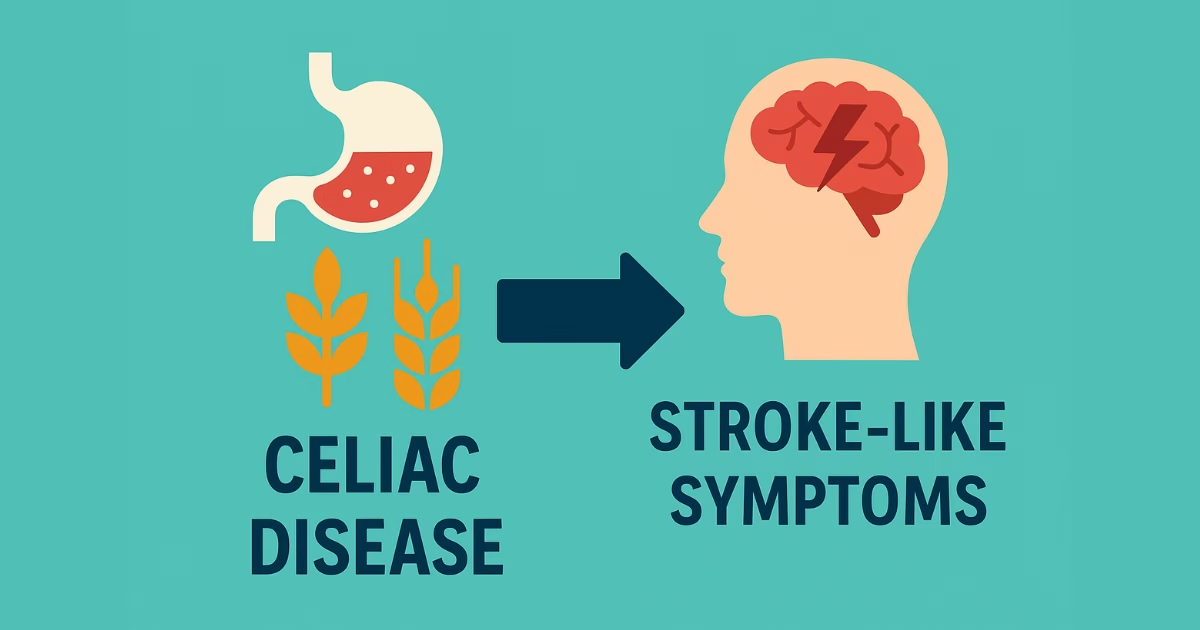Celiac disease is a chronic autoimmune disorder that primarily affects the digestive system, triggered by the consumption of gluten in genetically predisposed individuals. While its primary symptoms involve gastrointestinal distress, research has uncovered a less commonly discussed aspect of the disease—neurological symptoms. Celiac disease and stroke-like symptoms are becoming an increasingly recognized issue, where individuals with celiac disease experience neurological complications that mimic strokes. These symptoms may include difficulty with coordination, cognitive impairment, and even vision disturbances. Although these stroke-like symptoms are not actual strokes, they can still pose serious health challenges. Understanding the connection between celiac disease and these neurological issues is crucial for early diagnosis and effective management. In this article, we will explore the link between celiac disease and stroke-like symptoms, shedding light on potential causes, symptoms, and treatment options for those affected.
What Are Celiac Disease and Stroke-Like Symptoms?
Celiac disease is an autoimmune condition in which the body’s immune system mistakenly targets the small intestine when gluten—a protein found in wheat, barley, and rye—is consumed. This attack on the intestine leads to inflammation and damage, impairing nutrient absorption. The classic symptoms of celiac disease include chronic diarrhea, abdominal pain, bloating, and weight loss. However, it’s important to note that some individuals may not experience these typical gastrointestinal symptoms and instead present with neurological manifestations.
Stroke-like symptoms refer to neurological issues that resemble the signs of a stroke, such as loss of balance, weakness, or difficulty speaking. These symptoms can sometimes mimic a transient ischemic attack (TIA), a temporary blockage of blood flow to the brain. While true strokes are caused by disrupted blood flow to the brain, the stroke-like symptoms in celiac disease often arise from different causes, including inflammation, nutrient deficiencies, and autoimmune responses. These symptoms can range from subtle cognitive impairments, such as “brain fog,” to more noticeable motor difficulties, like problems with coordination and movement. Understanding the difference between these neurological symptoms and actual strokes is vital for proper diagnosis and treatment.
How Does Celiac Disease Lead to Stroke-Like Symptoms?
Celiac disease doesn’t just affect the digestive system; it can also have profound impacts on the nervous system. There are several ways in which celiac disease can lead to stroke-like symptoms, each related to the body’s immune response, nutritional deficiencies, and other neurological complications.
Gluten Ataxia and Coordination Issues
One of the most well-known neurological manifestations of celiac disease is gluten ataxia, a condition that affects coordination and balance. Gluten ataxia occurs when the immune system mistakenly attacks the cerebellum—the part of the brain responsible for motor control. This can result in symptoms similar to those experienced during a stroke, such as difficulty walking, poor coordination, and tremors. These symptoms often mimic those of a stroke but are actually due to the immune response to gluten.
Nutritional Deficiencies
Many individuals with celiac disease suffer from deficiencies in vital nutrients like vitamin B12, folate, and vitamin E due to malabsorption in the small intestine. These deficiencies can lead to neurological problems such as nerve damage, which in turn can cause symptoms similar to those of a stroke. A lack of B12, for example, can lead to numbness, tingling, and weakness, while vitamin E deficiency can cause motor difficulties.
Autoimmune Vasculitis and Blood Vessel Inflammation
Celiac disease is known to cause inflammation in the body, and in some cases, this inflammation can affect the blood vessels, particularly small vessels in the brain. This is referred to as autoimmune vasculitis, a condition in which the immune system attacks the blood vessels, leading to inflammation and narrowing of the blood vessels. As a result, blood flow to the brain can be compromised, leading to symptoms similar to those of a stroke, such as weakness, vision problems, or difficulty speaking.
Migraines and Their Role in Stroke-Like Symptoms
Another aspect of celiac disease that can contribute to stroke-like symptoms is the prevalence of migraines. Migraines with aura, a common symptom in celiac disease, can mimic stroke symptoms, such as visual disturbances, numbness, and even temporary paralysis on one side of the body. While these symptoms are not indicative of an actual stroke, they can cause considerable concern due to their resemblance to more serious neurological events.
Symptoms That Could Be Mistaken for a Stroke in Celiac Disease
There are several symptoms of celiac disease that might be confused with those of a stroke. These symptoms can vary in severity, and recognizing them as part of the disease is crucial for timely intervention.
Ataxia (Loss of Coordination and Balance)
Ataxia is one of the most common neurological symptoms in individuals with celiac disease. This condition can cause difficulty with balance and coordination, leading to falls or difficulty walking. These symptoms often resemble those of a stroke, where the brain’s ability to control movement is compromised.
Numbness, Tingling, and Weakness
Numbness and tingling in the limbs are common symptoms in people with celiac disease, particularly due to nerve damage resulting from vitamin deficiencies. These sensations can be similar to the neurological symptoms of a stroke, such as weakness or numbness on one side of the body. However, these symptoms are typically due to peripheral neuropathy or damage to the nerves, not an interruption in blood flow to the brain.
Cognitive Issues (Brain Fog and Confusion)
Another symptom that might be mistaken for a stroke is cognitive impairment. Many individuals with celiac disease report experiencing “brain fog,” a condition characterized by confusion, poor concentration, and memory issues. These cognitive difficulties can interfere with daily life and may resemble the confusion or disorientation often seen in stroke patients. Brain fog in celiac disease is thought to be caused by inflammation in the brain or by nutrient deficiencies.
Visual Disturbances
Visual disturbances, such as blurry vision, double vision, or even temporary blindness, can also occur in individuals with celiac disease. These symptoms can be alarming, as they are often mistaken for those experienced during a stroke. However, these disturbances are more commonly related to migraines, which are prevalent in individuals with celiac disease, or to damage caused by deficiencies in certain vitamins that are crucial for eye health.
Diagnosing Celiac Disease and Stroke-Like Symptoms
Diagnosing celiac disease and its neurological manifestations can be challenging, particularly when symptoms resemble those of a stroke. It’s crucial to differentiate between these conditions to ensure proper treatment and management.
Tests for Celiac Disease
The diagnosis of celiac disease typically begins with a blood test that looks for elevated levels of antibodies such as tissue transglutaminase IgA (tTG-IgA). If the blood test is positive, a biopsy of the small intestine may be performed to confirm the diagnosis. For individuals presenting with neurological symptoms, a doctor may also consider genetic testing to check for the presence of specific genes associated with celiac disease, such as HLA-DQ2 and HLA-DQ8.
Neurological Assessments
In order to rule out a stroke or other neurological conditions, doctors may recommend imaging tests like an MRI or CT scan. These tests can help identify any structural abnormalities in the brain, such as lesions, which could indicate a stroke or other vascular conditions. Neurological exams are also conducted to evaluate cognitive function and motor skills, helping to pinpoint whether the symptoms are truly related to a stroke or are a result of celiac disease.
Differentiating Between Stroke and Celiac Symptoms
Differentiating between stroke-like symptoms and those related to celiac disease requires careful assessment. A stroke is typically characterized by a sudden onset of symptoms, whereas the neurological symptoms related to celiac disease may develop more gradually over time. Additionally, individuals with celiac disease may have a history of gastrointestinal symptoms, which can provide clues to the diagnosis.
Treatment Options for Celiac Disease and Stroke-Like Symptoms
Treating stroke-like symptoms in celiac disease involves addressing both the underlying celiac disease and the neurological symptoms.
Gluten-Free Diet
The cornerstone of treatment for celiac disease is a strict, lifelong gluten-free diet. This helps to reduce inflammation and prevents further damage to the small intestine and brain. A gluten-free diet can significantly improve neurological symptoms, including ataxia and cognitive issues, by eliminating the immune response triggered by gluten.
Supplements for Deficiencies
Many individuals with celiac disease require supplementation to address deficiencies in vitamins such as B12, folate, and vitamin E. These deficiencies can contribute to neurological problems, and correcting them through supplements can improve symptoms such as numbness, tingling, and cognitive issues.
Managing Migraines and Other Symptoms
Treatment for migraines, a common issue in celiac disease, may include medications such as triptans or preventive treatments like beta-blockers or anticonvulsants. Additionally, managing symptoms like brain fog and ataxia may involve physical therapy and cognitive exercises to improve coordination and brain function.
Neurological Care
For individuals experiencing severe neurological symptoms, consultation with a neurologist is crucial. A neurologist can provide additional treatments to help manage symptoms and monitor any long-term neurological damage caused by celiac disease. In some cases, therapies such as physical or occupational therapy may be recommended to help patients regain lost motor skills.
Case Studies and Real-World Examples
Case Study 1:
A 35-year-old woman diagnosed with celiac disease began experiencing difficulty with coordination, tremors, and balance. These symptoms were initially misinterpreted as a stroke. However, after being evaluated for celiac disease and starting a gluten-free diet, her symptoms significantly improved within a few months. This case highlights the importance of considering neurological symptoms as part of the celiac disease spectrum.
Case Study 2:
A 50-year-old man with a long history of celiac disease began experiencing intense cognitive issues, including memory problems and confusion. His doctors initially suspected a stroke but found that his neurological symptoms were more likely linked to the autoimmune effects of celiac disease. With the introduction of B12 supplements and a strict gluten-free diet, his cognitive function improved over time.
When to Seek Medical Attention
Signs of an Actual Stroke:
While stroke-like symptoms can be a concern for people with celiac disease, it’s important to recognize the classic signs of a stroke. These include sudden weakness or numbness on one side of the body, difficulty speaking or understanding speech, and sudden loss of vision. If any of these symptoms occur, it’s critical to seek emergency medical attention immediately.
When Stroke-Like Symptoms Occur:
If stroke-like symptoms emerge in a person with celiac disease, it’s essential to consult with a healthcare provider as soon as possible. Early intervention can help prevent further complications and allow for proper diagnosis and treatment.
The Importance of Early Diagnosis:
Diagnosing both celiac disease and stroke-like symptoms as early as possible can help prevent permanent neurological damage and improve the quality of life for those affected. Early treatment, including dietary changes and vitamin supplementation, can lead to significant improvements in symptoms.
Conclusion
Celiac disease and stroke-like symptoms are often overlooked in many people with the condition, but they can significantly impact quality of life. By understanding the potential connection and recognizing the symptoms early, individuals with celiac disease can receive timely treatment to address both their gastrointestinal and neurological concerns. A gluten-free diet, proper supplementation, and neurological care can go a long way in managing these complex symptoms. If you or someone you know is experiencing stroke-like symptoms, it’s crucial to seek medical advice and consider celiac disease as a potential underlying cause.

Hi, I’m Shafy Ali – a curious mind and passionate writer at Celiac Magazine. I cover a little bit of everything, from everyday tips and how-tos to deeper dives into topics that spark conversation. I enjoy turning research into readable, relatable content that informs and inspires. Whatever the subject, I aim to keep it clear, engaging, and genuinely useful.

